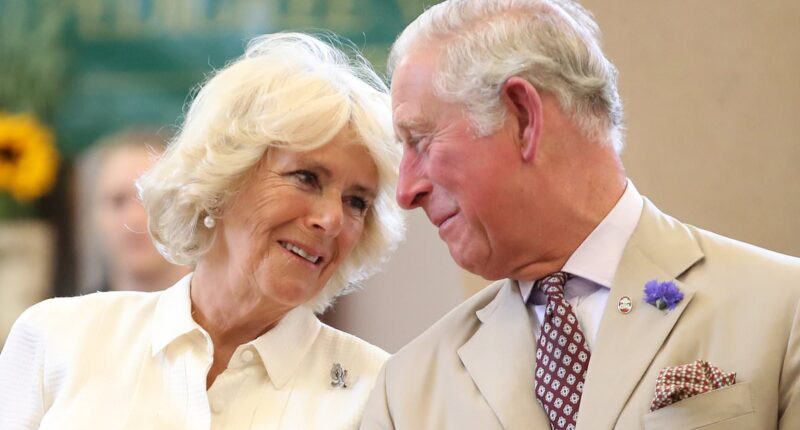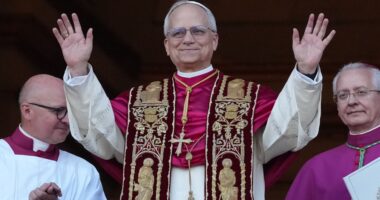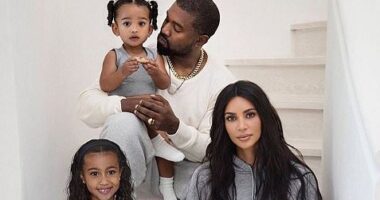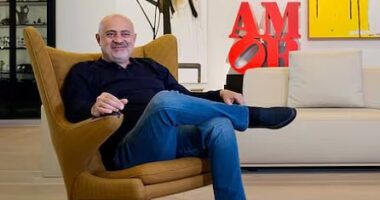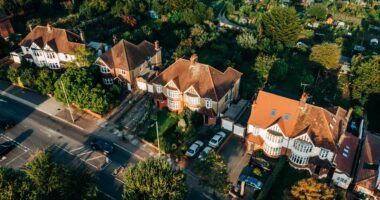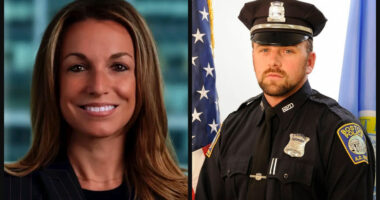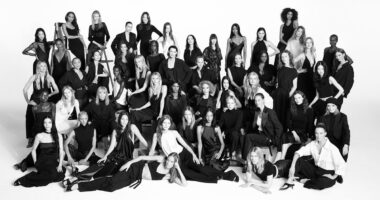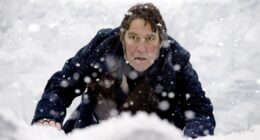The late Queen Elizabeth gave a remarkable speech during her reign, touching on topics such as horses and, surprisingly, love despite her usual reluctance to show emotions in public.
In a public endorsement of the marriage between the Prince of Wales and his longtime partner Camilla Parker Bowles, Her Majesty compared their enduring relationship to the challenges of the Grand National race.
During the Windsor wedding event, she likened their journey to overcoming challenging obstacles like Becher’s Brook, expressing her pride and well wishes for their future together: “They have come through and I’m very proud and wish them well. My son is home and dry with the woman he loves.”
That was back on April 9, 2005, which means that on Wednesday next week, unbelievably, the King, 76, and Queen, 77, will mark 20 years of marriage – albeit on a busy day of engagements in Rome as part of a state visit to Italy.
The romance that many had predicted would be the downfall of the monarchy has become one of its most enduring, if unconventional, love stories.
To mark their anniversary and to try to understand why Charles was willing to risk everything for Camilla – and why she was willing to put herself through almost unbearable public vilification for him – I have spent months talking to some of the couple’s closest friends, confidantes and advisors, some of whom have never spoken to the media before.
They have shed unprecedented light on the relationship – on what unites them, what they argue about and on the toll of the last, terribly difficult year.
Camilla’s sister Annabel Elliot, in a rare public comment, explains its success simply: ‘They have known each other for a long time, almost their entire lives.

Their secret ingredient is a good sense of humour: ‘And even if they argue, they will always laugh,’ says Camilla’s sister Annabel Elliot
‘Theirs, as any marriage should be, is a huge friendship. The key thing is that there is not really anything competitive between them. She is not trying to steal his thunder in any way at all. He is the King. And she will do her best to support him and be totally loyal to him.’
That’s not to say Camilla is a pushover. ‘She is a very strong character and she sticks to her guns,’ Ms Elliot says. ‘It’s quite extraordinary when I look back at how she has coped with everything.’
I ask her, is it love that still unites them after all these years?
‘Yes, that and loyalty,’ she replies. ‘She is incredibly loyal to people she loves… She is a very straightforward person. You always know where you stand.’
There’s another secret ingredient, Ms Elliot adds. Camilla’s ‘really good sense of humour’.
‘They rather like quite a lot of things going wrong. Things going wrong on a tour, or something like that,’ she tells me. ‘My sister is not the best person at controlling her laughter. My father would often have to separate us in church.
‘I like being part of their post-mortems afterwards, and my sister – which is quite a thing that is known to all our family – is quite prone to exaggeration.
‘And so the story often gets better and better and the King will [fondly] interject, “I’m not sure it’s quite like that darling”.’

Giving a very public blessing to the union of her son and Camilla, Her Majesty likened their long relationship to the Grand National. She said they had ‘overcome Becher’s Brook… and all kinds of other terrible obstacles’, adding: ‘They have come through and I’m very proud’
It’s as if Camilla’s sense of the ridiculous is a glue that holds them together.
‘I would almost say it’s the biggest gift she has given him,’ she explains. ‘The humour. It’s been such a bond between them. And even if they argue, they will always laugh.’
Although the couple do have their differences. As one family friend says: ‘Like any of us, they will disagree. Strongly. They both have their different views. And they will have a very good argument.’
What about?
‘Well,’ says the friend, ‘I think probably, particularly at the moment considering the King’s health in the last year, the main issue is that she can’t persuade him to take time out. She obviously worries about him and his [cancer] treatment. Except for the first couple of months, he’s pretty well worked every day since.’
Indeed, those in their circle say that the Queen was ‘worried sick’ after her husband was first diagnosed last year, as any partner would be.
‘It has been such a strain. It was worrying for them as a couple. You don’t know with cancer, do you?’ the friend adds.
‘The Royal Family don’t do illness… and I think that’s quite difficult for the Queen. Consequently, towards the end of last year she was quite ill herself. I think she was just exhausted because of all the travel and stepping up to the mark in his place.

The Queen told guests at Charles and Camilla’s Windsor wedding (pictured): ‘My son is home and dry with the woman he loves’
‘I would say argument-wise that is absolutely the top of what they disagree about. She thinks, like we all do, that he does far too much, hates letting people down. But hopefully not to the detriment of his own health.
‘They definitely have a renewed perception of what’s important to them 1743903267.’
Interestingly, the couple still spend significant periods apart, in what one source describes as the ‘quaintly old-fashioned, aristocratic way’, with Charles regularly disappearing off to Highgrove and Camilla to her private home, Ray Mill, in nearby Wiltshire for weekends
It may be anathema to many, but some of their friends say it is the ‘secret’ to their longevity and strength as a couple.
Others tell me I would be amazed at how ‘tactile’ they still are in private. ‘Sparks still fly!’ they say.
‘He is always entertaining her, making her laugh as they wait to go out in public, she rolling her eyes and letting him get on with it. And then you see them in these moments together when they are so tactile and affectionate, you think “Gosh, I didn’t expect that”. Their love is still very much alive.’
The ups and downs of Charles and Camilla have, of course, been well documented – with a little dramatic licence thrown in by the likes of Netflix’s The Crown for good measure.
They met in the 1970s and dated for two years before Charles was sent off to the Navy, which ended their blossoming romance.
Camilla went on to marry Andrew Parker Bowles in 1973 and had two children, Tom and Laura, but the marriage was not happy. Indeed several sources tell me she was very much ‘scarred’ by the experience, even though the two are great friends now.
Charles married Lady Diana Spencer in 1981 but, following the births of Princes William and Harry, that relationship broke down. And the world took sides.
Charles and Camilla, who are said to have resumed their relationship in 1986, were immediately branded the villains of the piece. Even their supporters admit that mistakes were made, but friends also tell me the situation was far from one-sided and Charles still deeply ‘regrets’ the pain and sadness caused.
‘Both of them [Charles and Diana] behaved badly in that first marriage and made decisions that none of us could ever condone,’ one says. ‘But we can seek to try to understand them.
‘When you look back on it now, asking someone to sacrifice… happiness for the sake of their public persona seems really quite cruel.’
When Camilla came back on the scene it was an incredibly challenging time for both herself and her family at the centre of a media storm. No one would have blamed her had she walked away. But a close friend insists: ‘I don’t think she was ever going to do that. She was committed to him.’
The path to acceptance was slow but in 1999 they appeared in public together for the first time leaving a birthday party for Ms Elliot at The Ritz in London.
While their engagement was finally announced in February 2005, permission for the marriage had, in fact, never been given.
I have spoken to several sources who have revealed the huge constitutional, political, religious – not to mention familial – hurdles that needed to be overcome behind the scenes. ‘The big question was would the Queen, and the Church, approve it? They were two tricky obstacles to overcome,’ one ex-courtier tells me.
As it turned out, one of the biggest challenges, I am told, was not the Queen but the then Archbishop of Canterbury, Dr Rowan Williams. A well-placed source informs me that he was ‘simply unwilling to grant them permission to get married in a church’.
‘In the end it was decided there would be a civil ceremony at the Guildhall in Windsor, which the Queen wouldn’t attend as head of the Church of England. But that she would be there for a blessing at St George’s Chapel and give a speech at the reception afterwards. It was an elegant compromise.’
The morning of April 9 itself saw the hailstorms that had plagued rehearsals the previous day replaced with spring sunshine and, more importantly, a sense of genuine celebration among the crowds. It was a huge relief to Clarence House staff, who had planned even for the possibility of the couple being pelted with eggs.
‘The Duchess of Cornwall [the title Camilla chose to use rather than Princess of Wales] was an absolute bag of nerves in the run up to it,’ says another source. ‘She was so terrified she couldn’t eat and felt sick… in fact she was actually sick, with sinus problems.

Princes Harry and William looking happy at Charles and Camilla’s wedding
‘On the day she was shaking so much she lost her place in the Order of Service during the ceremony and the Prince of Wales had to touch her hand to reassure her.
‘The police were on tenterhooks throughout the morning.
‘But people recognised at the centre of it all were two people who loved each other. Had the Queen said no, it wouldn’t have happened. But she wanted her son to be happy.
‘Anyone who was there, as I was, and heard the late Queen’s speech, which was warm, funny and gracious, couldn’t fail to see that she was happy for them.’
It’s worth noting that in his vitriolic memoir, Spare, Prince Harry claimed he and Prince William had begged their father not to remarry. My sources (and there are many of them) all agree on the fact that Harry enjoyed the nuptials, however.
‘My abiding memory about the wedding was how happy and excited Harry seemed,’ says one. ‘He and William came up with the idea of decorating their father’s Aston Martin as a send-off. He seemed pretty bought in.
‘I am sure there were mixed emotions over the years, but all I can tell you is how he seemed at the time. And he was happy for his father. This seems a very revisionist version of events.’
Aides are adamant that in the months and years after the wedding, there was no ‘grand plan’ for Camilla. Taking Prince Philip as an example, she embarked on a low-key programme of public engagements and carefully chosen patronages in a consciously supportive role to her husband.
The issue of whether she would one day be Queen hovered in the background, Clarence House announcing that it was ‘intended’ she would be known as Princess Consort when Charles acceded to the throne.
One Buckingham Palace source tells me, however, that ‘no one there ever thought she would be anything other than Queen’, not least because the King felt so strongly on the issue.
For him, it was less about the role and more about respect. ‘What other woman isn’t allowed to be called “Mrs X” and have the same right and privilege of a first wife?’ one insider says. ‘To have done otherwise would have been punitive.’
But this was something that no one was keen to force in a hurry, and Camilla herself was inscrutable – ‘sphinx-like’ – on the subject, refusing to discuss it even with family and friends.
One well-placed source stresses: ‘She had never been pushing for it. Never in a thousand years. Some people have said, “Oh, well, of course it was what she always wanted to become Queen”. But absolutely not.’
It was the late Queen who finally, in 2022 on the eve of her Platinum Jubilee celebrations, decided to sort the matter once and for all – knowing her life was coming to an end.

The royal couple get the giggles as they watch a performance of Henry Dagg’s Cat Organ during a visit to The Garden Party to Make a Difference at Clarence House in 2010
She announced without fanfare that it was her ‘sincerest wish’ that Camilla stand shoulder-to-shoulder with her husband as Queen Consort when the time came.
‘Her Majesty felt that it was important that it came from herself. If she accepted and wanted this, there was a greater chance that the country would do too,’ a former royal aide tells me.
‘The timing was quite deliberate. She knew she had a terminal illness and wanted the loose ends to be tied up. She knew her time was limited [Queen Elizabeth died in September that year].
‘But she also firmly believed that, much like her beloved late husband, her daughter-in-law hadn’t put a foot wrong. She had proved herself to be a loyal and loving wife and had stepped up to the plate in terms of public duties. In short, it was time – and she knew it needed to come from her.’
There is no doubt over the years that theirs has become a marriage of equals, with the King ‘eternally grateful’ to Camilla for agreeing to share this strange, and often quite lonely, life of his.
One former adviser tells me: ‘They have a brilliant working partnership and they bring out the best in each other.
‘She is also the most astute special advisor that the King could ever have. I don’t think people appreciate quite how good she is at it. He listens to her in a way he doesn’t necessarily listen to anyone else. She has the ability to go that last yard. Her only interest is his best interest.
‘He’s also so proud of the way she had handled everything she’s ever had thrown at her. He always finds a way to refer to his darling wife, his “mehabooba” [Urdu for beloved], in every speech.
‘Although it looks very privileged and luxurious from the outside, being Prince of Wales or King is a very lonely and pretty thankless job given the constant public scrutiny. She’s made it not just endurable but enjoyable for him. He adores her.’
‘At the heart of it,’ says another source (who I can assure you is not prone to effusive public statements), ‘is a love story, and an enduring one. A lot of the credit has to go to Camilla. She hasn’t put a foot wrong and is fiercely loyal to The Boss, as she calls him.
‘Yes, she rolls her eyes sometimes at his idiosyncrasies, particularly when he’s off on another long speech, but at the end of the day she is 100 per cent loyal to him and had the sense to know this was a marathon, not a sprint.’
So, will there be time for a little of that love and laughter next week as they mark two extraordinary decades of marriage?
‘Well they’ll be working, typically. And actually neither are particularly sentimental,’ a family friend says. ‘They will probably plant something in the garden, or maybe raise a glass and say, “Phew, darling can you believe it? How have we got this far?”’
